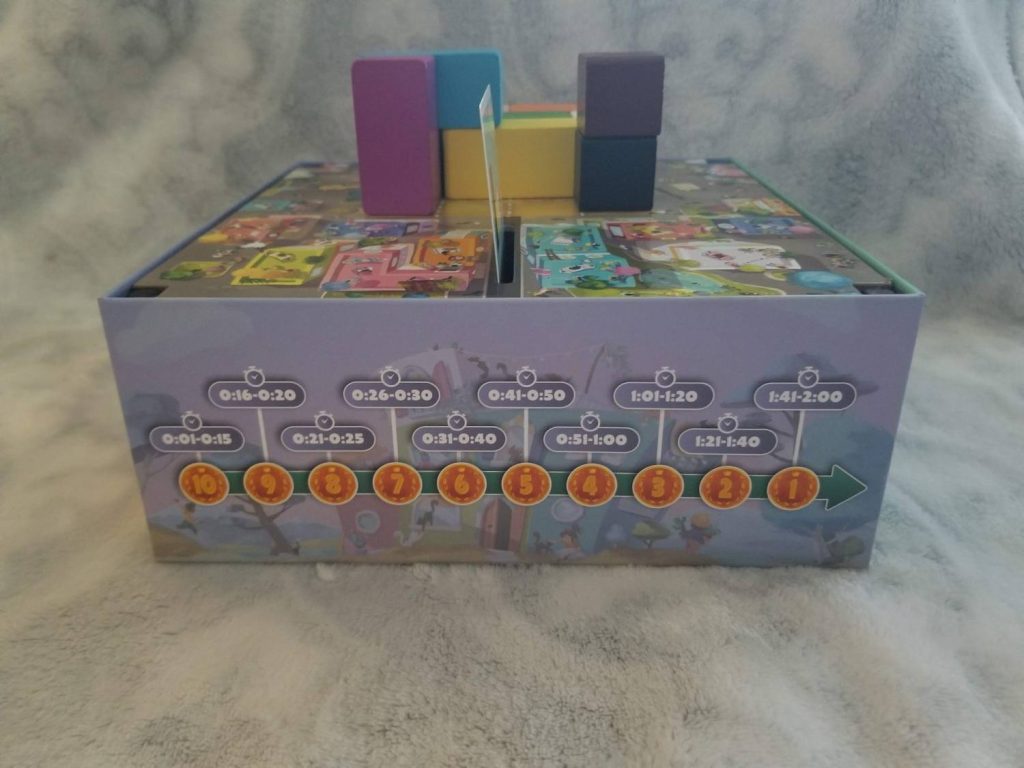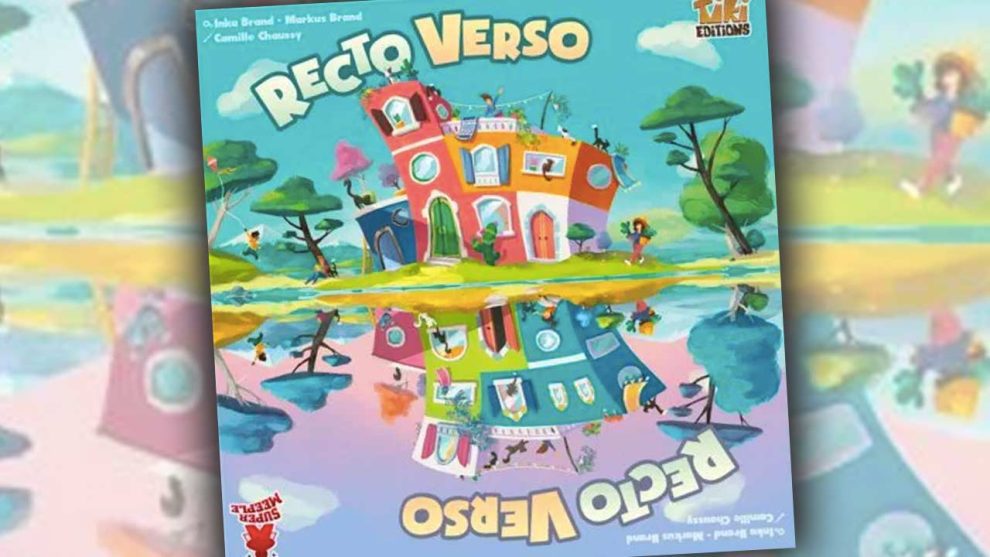Disclosure: Meeple Mountain received a free copy of this product in exchange for an honest, unbiased review. This review is not intended to be an endorsement.
In 2013, Inka and Markus Brand (The Rise of Queensdale, The EXIT series) released La Boca, a semi-cooperative, dexterity driven, spatial recognition game played with colorful wooden blocks. Its vivid table presence, fast paced and language independent game play, and simple ruleset landed it on the Spiel des Jahres jury’s Official Recommendation list that same year. Now, in 2022, the game has been reimagined and redesigned as Recto Verso. In addition to the original gameplay of La Boca, Recto Verso includes a two-player mode in addition to its standard three- to six-player mode.
Overview
In Recto Verso, the players will be taking turns pairing up and trying to arrange the game’s large, colorful wooden blocks to match the image shown on a card that is set between them. The trick is, each player can only see their own side of the card and they’re never allowed to look at the other side. The concept is simple, but the gameplay is anything but. Not only must every single block be used, but the puzzle must be solved within two minutes. The faster the puzzle is solved, the more points each player receives. And once every player has had an opportunity to pair with every other player, players count up their individual scores and the player with the highest score wins.
This high level overview is pretty much all you need to know in order to play the game. If you think you’ve heard enough and just want to know what I think, feel free to skip ahead to the Thoughts section. Otherwise, read on as we go into a little more depth about Recto Verso.
Setup
Recto Verso is set up thusly:

First, remove the tray that is used as the game play surface to reveal the storage wells beneath. Then, each player is assigned a color and takes the large and small markers in their color. Then they will give one of their small markers to each of the other players, placing any unused ones back into the box. Each player then flips the small markers they’ve received from the other players and shuffles them.
Next, select a deck of cards to play with. The cards with the red block on them are more difficult. The cards without are much easier. After selecting which deck to play with, place the other deck back into the box. Remove all the blocks from the box (leaving the red one if that deck was not selected). Remove the victory point tokens and keep them in a supply close by. Now, replace the tray, select a start player, and you’re ready to play.
A Round of Play
NOTE: The way the two-player game works is different and we’ll touch on that later. For now, I’m going to focus on the three- to six-player mode. In both modes, a timer will be needed. The original La Boca included a digital game timer, but no such thing is provided here. You can use a stopwatch or, if you’d prefer, the official Recto Verso timer app available on both Android and iOS platforms.
On a player’s turn, they will flip over one of the small markers in front of them to reveal the color on the other side. Whichever player matches that color will be their partner for the round. The box is situated between the players with the card slot situated horizontally between them. Then, one of the players draws a card from the stack of cards and places it into the card slot, keeping the visible portion hidden. Then, when one of the players says ‘Go’ the stopwatch is started and the active players begin working together to solve the puzzle.

Each side of the visible portion of the card is going to display a different combination of colors in different arrangements. The play area is divided into a four by four grid. The challenge that the active players face is trying to stack, turn, and sometimes even hide the blocks so that, from their perspective, each player is seeing the image depicted on their side of the card once all of the blocks have been placed. The card does not care about depth of field. It sees the world in flat 2D.
The rulebook suggests a practice round so that players can fully grasp the way that this works and I highly recommend that as well. Just so that you, dear readers, can understand it, consider the following image:

The two players are allowed to communicate freely, but they are not allowed to look at the other player’s side of the card. The first player to complete their side yells “Recto!”. When the second player finishes, they yell “Verso!” and then the stopwatch is stopped. When both sides are verified, the players receive points based on how quickly they were able to solve the puzzle. If an error was made or it took more than two minutes, neither player receives points. Otherwise, the graph on the sides of the box displays the time segments and how much they are worth. In general, though, the faster you are, the more points you’ll score. The players are awarded the requisite amount of victory point tokens.

Then play passes to the next person in clockwise order. This cycle is repeated until all players have paired with each other. Then the points are tallied and whoever has collected the most wins.
Two-Player Mode
For the most part, the two-player mode is played exactly the same as the three- to six-player mode with a few notable differences. For starters, the two-player mode is played on the opposite side of the game board. Flipping this over will reveal a track, numbered from one to seven, with a crown on the last spot. Included in the box is a marker for the two-player mode which is placed onto the first spot of the track. As each puzzle is solved, the marker moves up to the next spot.
The goal of the two-player game is to solve seven puzzles in a row. But, there’s a catch. For the first puzzle, you’re only given a total of one minute, thirty seconds in which to solve it. Each consecutive round will allow fifteen seconds less than the previous round—except rounds five and six which differ by only ten seconds and round seven which differs from round six by only five seconds. That means that in order to complete the puzzle in round seven and win the game, you’ll have to solve the puzzle in a mere fifteen seconds.
Thoughts
Inka and Markus Brand are two of my favorite designers, so I was elated when I was offered the opportunity to review this game. When it first arrived, after opening the box, I was concerned that this was just going to be another silly party game or so ridiculously easy as to not be worth my time.
If you’re anything like me, when you lay your eyes on this game’s components, you might find yourself lulled into thinking Recto Verso is a kid’s game. Indeed, it does have a very HABA-esque look to it. But, don’t let the cartoony artwork or the wooden blocks fool you. There’s nothing easy about this game.
You will be tested. You will fail. You will succeed. You will laugh. Heck, you might even cry a few times before it’s all done. Regardless of how well you perform, you’re guaranteed to have fun.
I’ve never played the two-player mode, so I cannot comment on it other than to tell you that solving one of these puzzles in fifteen seconds seems almost impossible. That’s an observation based on my other experiences with the game at every other player count. At those player counts, I found myself consistently challenged by each and every card that got pulled, even when I wasn’t one of the active players. It’s hard to not feel engaged when playing this game and it’s even harder to keep your mouth shut when you see your opponents struggling to solve such an easy puzzle oh my god come on you almost had it you were right there.
Whoa. I went off on a tangent there. But playing Recto Verso is exactly like that. The engagement factor in this game is very, very high. You can’t play this game and not feel involved in the outcome. It’s impossible. When it’s not your turn, you’ll find yourself dying to be next in line. And when it is your turn, you’ll be wishing it would never end.
But, as they say, all good things must come to an end. And when that inevitable end comes twenty to thirty minutes later, well, it’ll feel like time well spent.












Add Comment